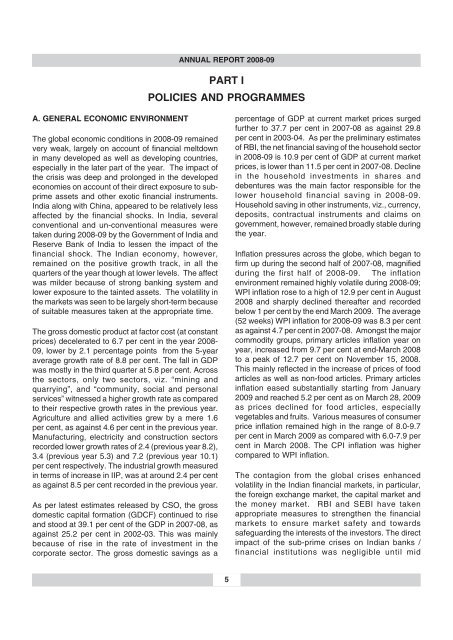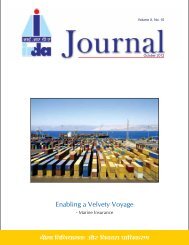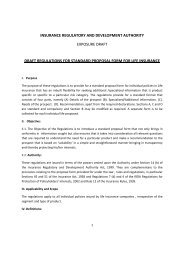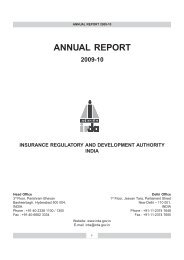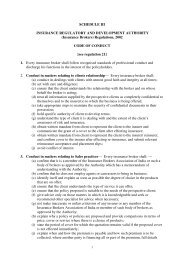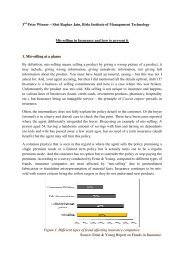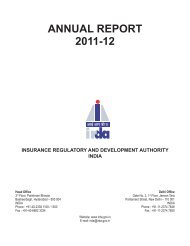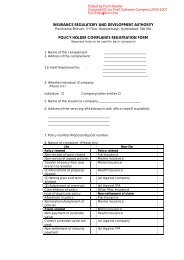annual report 2008-09 - IRDA
annual report 2008-09 - IRDA
annual report 2008-09 - IRDA
Create successful ePaper yourself
Turn your PDF publications into a flip-book with our unique Google optimized e-Paper software.
ANNUAL REPORT <strong>2008</strong>-<strong>09</strong><br />
PART I<br />
POLICIES AND PROGRAMMES<br />
A. GENERAL ECONOMIC ENVIRONMENT<br />
The global economic conditions in <strong>2008</strong>-<strong>09</strong> remained<br />
very weak, largely on account of financial meltdown<br />
in many developed as well as developing countries,<br />
especially in the later part of the year. The impact of<br />
the crisis was deep and prolonged in the developed<br />
economies on account of their direct exposure to subprime<br />
assets and other exotic financial instruments.<br />
India along with China, appeared to be relatively less<br />
affected by the financial shocks. In India, several<br />
conventional and un-conventional measures were<br />
taken during <strong>2008</strong>-<strong>09</strong> by the Government of India and<br />
Reserve Bank of India to lessen the impact of the<br />
financial shock. The Indian economy, however,<br />
remained on the positive growth track, in all the<br />
quarters of the year though at lower levels. The affect<br />
was milder because of strong banking system and<br />
lower exposure to the tainted assets. The volatility in<br />
the markets was seen to be largely short-term because<br />
of suitable measures taken at the appropriate time.<br />
The gross domestic product at factor cost (at constant<br />
prices) decelerated to 6.7 per cent in the year <strong>2008</strong>-<br />
<strong>09</strong>, lower by 2.1 percentage points from the 5-year<br />
average growth rate of 8.8 per cent. The fall in GDP<br />
was mostly in the third quarter at 5.8 per cent. Across<br />
the sectors, only two sectors, viz. “mining and<br />
quarrying”, and “community, social and personal<br />
services” witnessed a higher growth rate as compared<br />
to their respective growth rates in the previous year.<br />
Agriculture and allied activities grew by a mere 1.6<br />
per cent, as against 4.6 per cent in the previous year.<br />
Manufacturing, electricity and construction sectors<br />
recorded lower growth rates of 2.4 (previous year 8.2),<br />
3.4 (previous year 5.3) and 7.2 (previous year 10.1)<br />
per cent respectively. The industrial growth measured<br />
in terms of increase in IIP, was at around 2.4 per cent<br />
as against 8.5 per cent recorded in the previous year.<br />
As per latest estimates released by CSO, the gross<br />
domestic capital formation (GDCF) continued to rise<br />
and stood at 39.1 per cent of the GDP in 2007-08, as<br />
against 25.2 per cent in 2002-03. This was mainly<br />
because of rise in the rate of investment in the<br />
corporate sector. The gross domestic savings as a<br />
percentage of GDP at current market prices surged<br />
further to 37.7 per cent in 2007-08 as against 29.8<br />
per cent in 2003-04. As per the preliminary estimates<br />
of RBI, the net financial saving of the household sector<br />
in <strong>2008</strong>-<strong>09</strong> is 10.9 per cent of GDP at current market<br />
prices, is lower than 11.5 per cent in 2007-08. Decline<br />
in the household investments in shares and<br />
debentures was the main factor responsible for the<br />
lower household financial saving in <strong>2008</strong>-<strong>09</strong>.<br />
Household saving in other instruments, viz., currency,<br />
deposits, contractual instruments and claims on<br />
government, however, remained broadly stable during<br />
the year.<br />
Inflation pressures across the globe, which began to<br />
firm up during the second half of 2007-08, magnified<br />
during the first half of <strong>2008</strong>-<strong>09</strong>. The inflation<br />
environment remained highly volatile during <strong>2008</strong>-<strong>09</strong>;<br />
WPI inflation rose to a high of 12.9 per cent in August<br />
<strong>2008</strong> and sharply declined thereafter and recorded<br />
below 1 per cent by the end March 20<strong>09</strong>. The average<br />
(52 weeks) WPI inflation for <strong>2008</strong>-<strong>09</strong> was 8.3 per cent<br />
as against 4.7 per cent in 2007-08. Amongst the major<br />
commodity groups, primary articles inflation year on<br />
year, increased from 9.7 per cent at end-March <strong>2008</strong><br />
to a peak of 12.7 per cent on November 15, <strong>2008</strong>.<br />
This mainly reflected in the increase of prices of food<br />
articles as well as non-food articles. Primary articles<br />
inflation eased substantially starting from January<br />
20<strong>09</strong> and reached 5.2 per cent as on March 28, 20<strong>09</strong><br />
as prices declined for food articles, especially<br />
vegetables and fruits. Various measures of consumer<br />
price inflation remained high in the range of 8.0-9.7<br />
per cent in March 20<strong>09</strong> as compared with 6.0-7.9 per<br />
cent in March <strong>2008</strong>. The CPI inflation was higher<br />
compared to WPI inflation.<br />
The contagion from the global crises enhanced<br />
volatility in the Indian financial markets, in particular,<br />
the foreign exchange market, the capital market and<br />
the money market. RBI and SEBI have taken<br />
appropriate measures to strengthen the financial<br />
markets to ensure market safety and towards<br />
safeguarding the interests of the investors. The direct<br />
impact of the sub-prime crises on Indian banks /<br />
financial institutions was negligible until mid<br />
5


